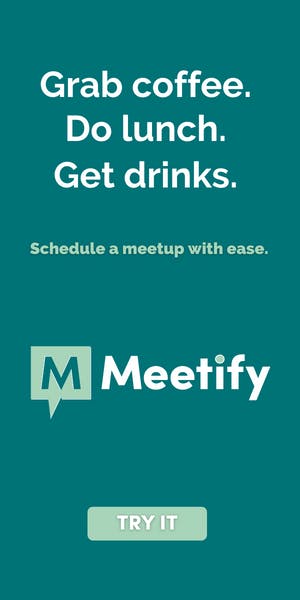
What's in a (Brand) Name?
How We Chose to Name the Company "Meetify"
Angel Rutledge
Co-founder, Meetify
Published: Sep 20, 2022
I expected choosing a name for the company to be a lot of fun, and it was. Though one part of the process was harder than we anticipated, and the part we thought would be tough wasn’t too challenging. A lot of things in life are like that, aren't they?
We thought the tough part would be for us to agree on a name. That's mainly because we both wanted to be the one to come up with it. We both like to create and also we're competitive, so we started with separate spreadsheets to brainstorm ideas and avoid feedback too early on.
Initially, Dan’s favorite name was “Grunch.” He liked the sound of the word, the short length and the combination of the words “grab” and “lunch.” Its tech vibe spoke to him and since people often meet over a meal, it felt ideal. My initial favorite was “SimplyMeet.” I liked that it combined the core product purpose with the brand promise, and it would be easy for new customers to know what to expect from us. A key part of brainstorming is to get better ideas by coming up with a lot of them so we did. We had over 200 options by the time we moved to narrowing them down.
Our next step was to trim our list to seven names we both liked before presenting them to a group for feedback. The criteria we used to get to the top brand name contenders were:
Domain name affordability
This is an important measure that every founder is likely to hit up against. It’s very difficult to find a domain name that isn’t already registered if a founder’s goal is to use a real word or phrase that’s reasonably short and easy to spell. If that’s a goal, then concessions will need to be made. Either you have to give up getting a “.com” extension, you have to make up a word to use as the name, or you need to combine words that typically wouldn’t be combined. Otherwise, domains can cost anywhere from the low four digits to the low eight digits. Our budget was in the low five digits. After narrowing the list to names we thought we could afford, we moved on to other criteria.
No registered trademarks
While it’s likely that any domain name we could afford wouldn’t already have a registered trademark, it was a good safety check. Doing a trademark search is simple and free.
Ten characters or less
There were a few things we were thinking about here. Typically, the shorter the word, the easier it is to remember. Super important for people trying to get to the site. Plus, even though Google would say shorter domains don’t lead to better SEO, shorter domains do in fact tend to have better SEO. So even if there isn’t a cause and effect relationship, there is a correlation. Also, a shorter company name is better for logo design and branding. Think about a company name and logo on a t-shirt. Would you prefer a t-shirt with a 4-7 character, one word company name or a 16-20 character, three word name? Plus, the shorter the name, the easier it is to type it out. Not only is that ideal for anyone doing a Google search for the company. We also knew from experience that it would be a lot easier to work for a company with a shorter domain name, especially when typing out our email addresses.
Easy to spell
This goes with most of the reasons it’s good to have a shorter company name. Most importantly, it makes it easy for people to find the site. Another issue is dealing with autocorrect. Even if a name seems easy to spell, if autocorrect tries to change it, it would be a daily pain for people at the company. Even worse, it would be an irritation every time people tried to get to the site. Not the impression we wanted to lead with.
Positive vibes
We wanted to evoke a trustworthy, simple tech vibe. Knowing the company name would likely be the first impression potential customers got of our brand, this criterion was especially important to us. We also played around with options that created a playful or cool vibe. It was interesting to see how people responded to each name based on this one criterion.
Clear product function
We wanted a name that would clearly communicate the main functionality of our product that would also be broad enough to include other products if we chose to create any in the future. We both agreed that the most important criterion was that the name should identify the purpose of the product. The most basic purpose is to help people meet up in person. More specifically, it’s useful to help them find a convenient spot to meet at a time that works best for them. Our brand promise is that this should be simple to do.
Strong branding potential
Beyond the vibe the name would evoke, we also thought about the story we would like to tell about our customers being people who get why it’s important to meet face-to-face with others and how we know their time is so important they need that process to be simple. The name needed to lend itself to a brand that is efficient, powerful and simple to use while still being a brand that can be trusted to care about its customers and the relationships they build through meetings. A lot to ask of a name? For sure.
Memorability
The previous criteria all add up to making a company name memorable. When we evaluated a name based on its memorability, we were asking if all of those criteria were working together in a particular name. In some cases, only one aspect really stood out, which helped us whittle down the list to the top seven.
Obvious tech company
This criterion could have been dropped, but it had value to us. If we were planning to be a B2C business that sold only to consumers, we wouldn’t care about this criterion too much. Since we’re planning to also have a strong B2B focus, we decided it would be important for the name to communicate it’s a tech company.
The Survey
We chose a group of people to survey who are knowledgeable about tech companies, diverse in ages, genders and ethnicities and are potential customers. To ensure their feedback, I kept the survey under two minutes in length.
I started the survey with two simple sentences.
“A new SaaS company needs your input to decide on a name. The company's software makes it simple to schedule in person communication at a central location for two or more people.”
I wanted everyone evaluating the names according to the same criteria that we were, so in the first section of the survey I laid that out.
Then, I asked them to rank their top three choices for names. This was super helpful for obvious reasons. Finally, I asked for a brief response regarding what they liked about their first choice and then for their second choice. Letting them know we only expected brief responses ensured that everyone gave input here. Whether it was a phrase or two or multiple sentences, this feedback really gave us a window into the first impressions the top two names conjured up for each respondent.

First impressions are important for brands
The survey feedback was incredibly useful. It allowed us to see that each of the seven names worked on some level, but that three of them stood out from the pack. That took the pressure off of me and Dan to argue for our favorites, which by this time included more than one for each of us. It also helped us confirm that we were on the right track. The respondents gave us feedback that mostly agreed with what we were thinking and also had some minor surprises that helped us come to more of a consensus with each other on the final three. If we had the survey to do all over again, I would ask if there were any names respondents didn’t like and a brief response about what they didn’t like. That was one thing we were left wondering.
Once we had the final three contenders, we spent a week figuring out if it would be easy to buy any of the three on our own. It wasn’t. This is the part that was a lot more challenging than we expected. I could go into another whole post on what we learned about domain buying that changed in the several years since Dan last purchased any.
Simply put, I’d recommend a founder only buy a domain name on their own if it’s immediately available at a domain registrar or they can easily find out the seller’s price on their own. Even then, if the seller is asking more than five thousand dollars, I’d still recommend a domain name broker. They tend to charge a 10%-15% commission on the sales price, and it’s totally worth it. Not only are they very knowledgeable about how to find sellers and negotiate the best price, they also follow the process all the way until the domain is transferred to the buyer's account at the domain name registrar of the buyer's choosing.
Finding a broker who is reputable, matches the way you like to do business and works on domains in your price point can be a little tricky, but I was able to talk to three people on the phone before deciding. I narrowed it down with good old Google searches, LinkedIn stalking and reviewing any content they had created. One I talked with, Alan Dunn at NameCorp.com, worked on domains above our price point, but he pointed me to Brooke Hernandez at Saw.com, which is who we ended up working with. She was fantastic. Professional, up front, efficient and came in under budget for the domain and her costs.
In the end, we didn’t need to worry about who would get to claim naming rights for the company. By the time all was said and done and we got Meetify.com, it was the first choice for both of us. Even better, it appeared on both of our brainstorming lists. Arm wrestling duel averted. This time.


© 2026 Meetify. All rights reserved.
Privacy Policy Terms of ServiceWe use cookies to help you have the best experience using Meetify. Click "Accept All" to consent to our use of cookies. Privacy Policy


